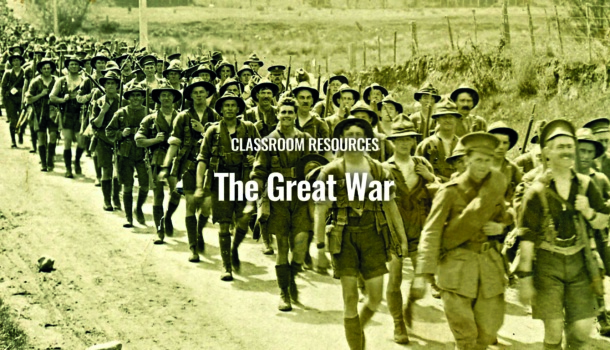The Great War Cross Curriculum Project
The Great War resource packs include instructions, activity sheets, information factsheets, research resources and images to support the lesson plans and activities, plus a series of country resource packs focusing on Austria-Hungary, France, Germany, Great Britain, Russia and Serbia and their role in the start of World War I. This cross curricular project plan includes:
£25+ VAT
Purchase this teaching resource
- up to 300 users
- up to 300 users
- up to 300 users
‘The Angel of Mons’ text A non-fictional text explaining the events of the Battle of Mons – one of the first major battles of World War I – and the legend that surrounds the lack of casualties, despite the British being outnumbered and forced to retreat. The text can be found in Activity 1 Resource Pack.
Activity 1: Reading the text
The purpose of this activity is to encourage active thinking and reading through close examination of the text, ‘The Angel of Mons’, using the reciprocal reading roles: summariser, predictor, clarifier, questioner.
Activity 2: The path to war
Students identify events leading to the Great War, determining which causes were the most/least important, before examining one country’s motives for joining the war in more detail.
Activity 3: Timeline of the Great War
Students create a timeline, covering events leading up to and during the Great War.
Activity 4: Propaganda research exercise
Students use research skills to identify the purpose of propaganda and create a propaganda poster.
Activity 5: The sinking of the Lusitania
Students use research skills to identify the significance of the sinking of the Lusitania and write a descriptive account of this maritime disaster.
Activity 6: The Trenches
Students use a range of resources to write diary entries and letters home from the trenches. The second section of this activity has students solving a number of mathematical problems relating to the trenches.
Activity 7a: Gas attack
Students read and discuss the poem ‘Dulce et Decorum est’ by WW1 soldier, Wilfred Owen. From there, they either recreate the poem in drama, or write their own poem about a gas attack. Project Overview The Great War © Imaginative Minds Ltd.
Activity 7b: The ethics of chemical warfare
Students use prior knowledge from the previous activity to conduct a P4C enquiry into the use of poisonous gases during WW1. The starting point for this enquiry is the Hague Convention of 1899 which outlawed the use of chemical weapons.
Activity 8: Helping the wounded
A research task, focusing on advances in reconstructive surgery and prosthetic limbs during and soon after the First World War.
Activity 9: Spies
Students research the link between 11 names, writing up a brief report of the events surrounding each person’s demise. The activity culminates with students drawing and justifying their conclusions as to the justness of each person’s fate.
Activity 10: Armistice
Students investigate the end of the Great War and the armistice, and its impact on Germany and the rest of Europe, drawing conclusions and presenting their findings.
Activity 11: Shot at dawn
Students use the text provided and their own research to write an argument either for or against pardoning the men who were executed for cowardice during WW1.
Activity 12: Statistics from the Great War
Students read and use data from World War I to produce comparative graphs.
Activity 13: Creating a culturegram
Students create a culturegram (an image bank) about the lives of people in 1914.
